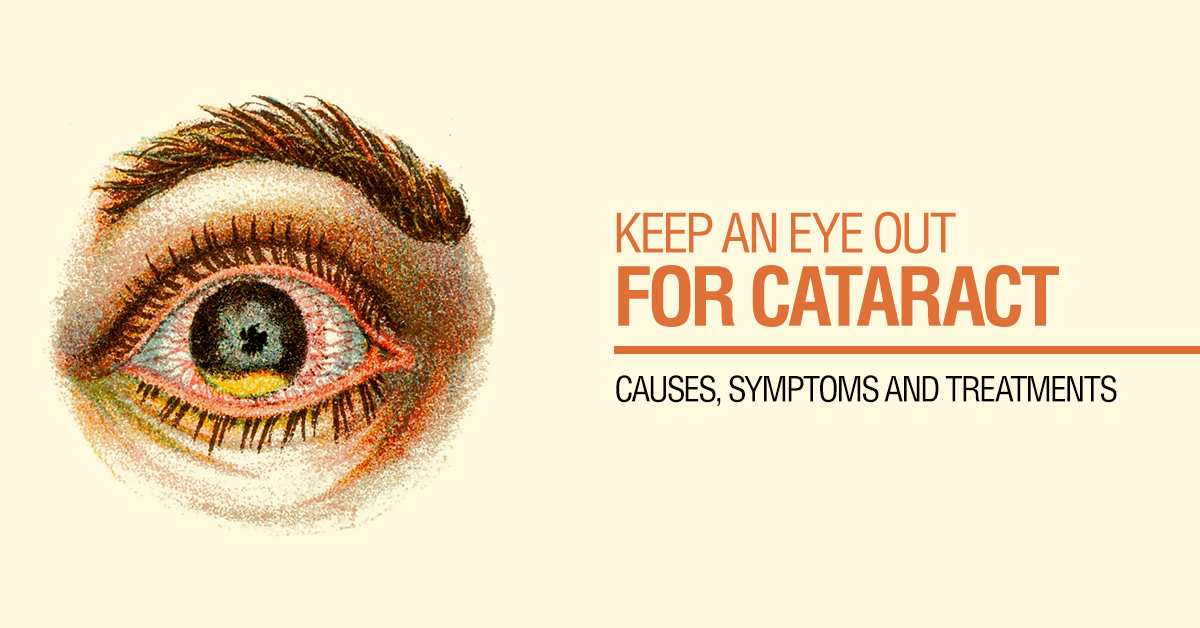Keep an Eye out for Cataract: Causes, Symptoms and Treatments

What Are Cataracts?
A cataract is a progressive, painless clouding of the natural, internal lens of the eye. It begins when proteins in the eye form clumps that prevent the lens from sending clear images to the retina. The retina works by converting the light that comes through the lens into signals. It sends the signals to the optic nerve, which carries them to the brain. For people who have cataracts, seeing through cloudy lenses is a bit like looking through a frosty or fogged-up window. Clouded vision caused by cataracts can make it more difficult to read, drive a car (especially at night) or see the expression on a friend’s face. You might end up with cataracts in both eyes, but they usually don’t form at the same time.
Causes of Cataracts
Ageing is the most common cause. This is due to normal eye changes that happen to start around age 40. That is when normal proteins in the lens start to break down and clump together. This clump makes a cloudy area on your lens — or a cataract. People over age 60 usually start to have some clouding of their lenses. However, vision problems may not happen until years later.
However, other factors can also contribute to cataract development, including:
– Diabetes
– Ultraviolet radiation
– Smoking
– Alcohol
– Nutritional deficiency
– Long-term use of steroids and other medications
– Trauma
– Radiation therapy
Symptoms of Cataracts
Cataracts cause more vision problems globally than any other eye condition or disease. Some of the common symptoms of this disease are:
– Blurry, cloudy, or misty vision at any distance is the most common symptom of cataract. Over time, as cataracts get worse, less light reaches the retina.
– Vision may be affected by small spots or dots.
– Seeing colours as faded.
– Halos surrounding lights.
– A need for frequent changes in prescription glasses.
– An early symptom of cataracts is glare or sensitivity to light. You may have trouble seeing in bright sunlight. Driving at night may become a problem because of the glare caused by street lights and oncoming headlights.
– The patient sees small patches that blur parts of the field of vision.
– Have double vision (also known as diplopia) in one eye. This is different from the double vision that comes from the eyes not lining up properly. With cataracts, images can appear double even with one eye open.
Cataracts Treatments
This will include an eye chart test to check your vision at different distances and tonometry to measure your eye pressure. The most common tonometry test uses a painless puff of air to flatten your cornea and test your eye pressure. Your doctor will also put drops in your eyes to make your pupils bigger. This makes it easier to check the optic nerve and retina at the back of your eye for damage. Other tests your doctor might perform include checking your sensitivity to glare and your perception of colours.
At first, stronger lighting and eyeglasses can help you deal with cataracts. But if impaired vision interferes with your usual activities, you might need cataract surgery. Fortunately, cataract surgery is generally a safe, effective procedure. It involves removing the lens of the eye and replacing it with an artificial lens. The artificial lens requires no care and can significantly improve vision. Some artificial lenses have the natural focusing ability of a young healthy lens.
Regency Hospital provides expertise to treat all kinds of eye-related problems ranging from routine eye examinations to state-of-the-art diagnostics.

 Call-an-Ambulance
Call-an-Ambulance



